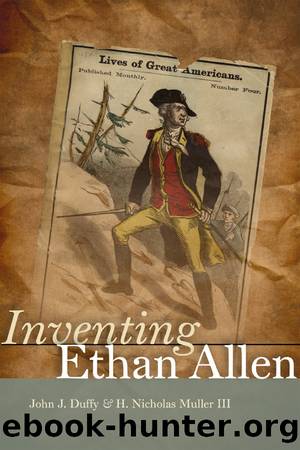Inventing Ethan Allen by John J. Duffy

Author:John J. Duffy
Language: eng
Format: epub
Publisher: University Press of New England
DID ETHAN ALLEN KILL ANYONE?
Historians and others have not seriously pursued the question of whether Ethan Allen took a human life. Considering that most of Allen’s biographers since the 1830s have repeated his fierce threats to kill recusant Yorker settlers, destroy their homes, and level every building in Yorker settlements, only John Pell opened the question of whether Ethan Allen took a human life. He bathetically concludes, however, that “on most occasions, he treated his victims with unexpected leniency. The only casualty in the war of the New Hampshire Grants was a pitiable dog named Tryon.”6 Allen relates in the narrative of his captivity that one of the “centries” at Fort Ticonderoga charged one of his men with a bayonet. Composing his narrative in 1779 he recalled, “My first thought was to kill him with my sword.” But, he continued calmly, “in an instant, [I] altered the design and fury of the blow to a slight cut on the side of the head,” and transformed himself in memory into an oxymoronic nonviolent warrior.7 He did not take a life in the Great Cow War at the pesky Tory nest in Guilford or at “the siege of Vallumcock” where he and the Vermont militia faced off the Yorkers over the West Union. No record attests to his taking a life while scouting for General Montgomery and the Americans who invaded Canada in 1775 or his having killed anyone in the fight that ensued in his ill-conceived thrust against Montreal. Yorker depositions document his violent language and behavior as the Green Mountain Boys terrorized Yorker settlers on the Grants and his threats to take lives. A few clues suggest that he might have killed at least one of his Yorker opponents. The conjecture begins with his second marriage in 1784, itself a confection of the mid-nineteenth century firmly embedded in the story of Ethan Allen.
The unquestioning repeated reliance on William Czar Bradley’s account of Ethan Allen’s marriage to Frances Montresor Buchanan as a whirlwind, sentimental romance may have had the effect of blinding students to the financial aspects of Ethan Allen marrying a woman with a claim to thousands of acres of prime land. And it may have also excluded consideration and investigation into the longstanding antagonism between the groom and the man who had raised the bride and whose landed wealth had enriched her, the arch Tory Crean Brush, the chief author of the New York Provincial Assembly’s Bloody Act of 1774 that declared Ethan and his lieutenants guilty of a capital crime without benefit of trial.8
According to Benjamin H. Hall writing in 1857, when Brush took his family two hundred miles north to settle on the west bank of the Connecticut River in Westminster, his city fashion in clothing “contrasted strongly with the simple garb of the villagers, and for some time pomp and parade availed to conceal the defects of character.” The country mice soon saw the flashy city mouse was really a rat. Hall established the dramatic structure
Download
This site does not store any files on its server. We only index and link to content provided by other sites. Please contact the content providers to delete copyright contents if any and email us, we'll remove relevant links or contents immediately.
Blood and Oil by Bradley Hope(1529)
Wandering in Strange Lands by Morgan Jerkins(1372)
Ambition and Desire: The Dangerous Life of Josephine Bonaparte by Kate Williams(1344)
Daniel Holmes: A Memoir From Malta's Prison: From a cage, on a rock, in a puddle... by Daniel Holmes(1293)
It Was All a Lie by Stuart Stevens;(1265)
Twelve Caesars by Mary Beard(1256)
The First Conspiracy by Brad Meltzer & Josh Mensch(1140)
What Really Happened: The Death of Hitler by Robert J. Hutchinson(1128)
London in the Twentieth Century by Jerry White(1112)
Time of the Magicians by Wolfram Eilenberger(1088)
The Japanese by Christopher Harding(1086)
Twilight of the Gods by Ian W. Toll(1084)
Cleopatra by Alberto Angela(1062)
A Woman by Sibilla Aleramo(1052)
Lenin: A Biography by Robert Service(1045)
The Devil You Know by Charles M. Blow(985)
Reading for Life by Philip Davis(971)
The Life of William Faulkner by Carl Rollyson(925)
1965--The Most Revolutionary Year in Music by Andrew Grant Jackson(920)
